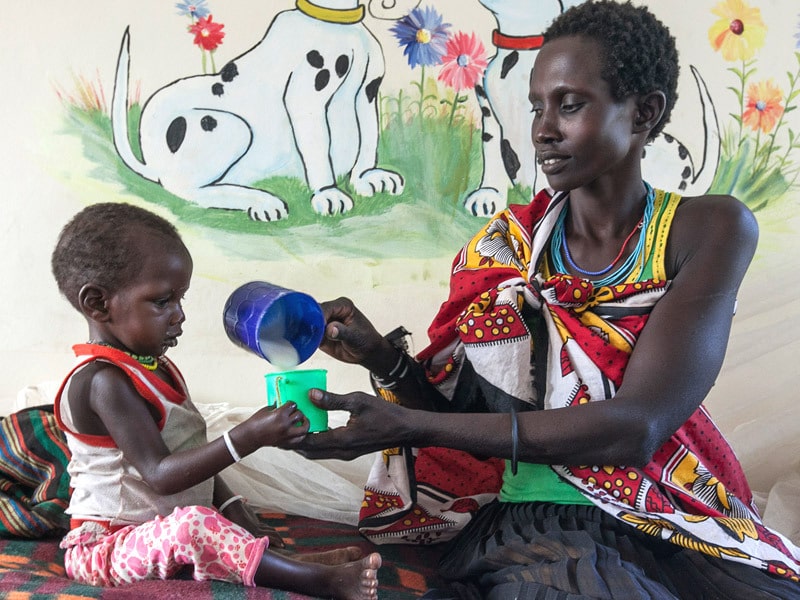
Malnutrition is associated with a lack of food, disease and low socio-economic status. Malnutrition, is a “condition resulting from a lack of absorption or intake of nutritional substances, leading to a change in body composition, impairment of physical and mental functions of the body and adversely affecting the outcome of treatment of a primary disease”.
Our body is nourished by major macroelements such as proteins, fats and carbohydrates. Adequate energy supply with a daily ration (kilocalories from the food) is also extremely important. Vitamins (e.g. vitamin A, C, D, E, B vitamins) and minerals (such as calcium, magnesium and chromium) also play an important role in the proper metabolism of macroelements.
Dietary diets that are one-sided and therefore based, for example, on only one main macro-ingredient and, for various reasons, do not provide the right amount of kilocalories can lead to malnutrition of the patient.
Not only unilateral diets can be a problem. Hunger, caused by various factors, is the main cause of malnutrition development. Starvation can be divided into:
- simple starvation
Due to the lack of food supply, glycogen (about 72 h of starvation) is quickly depleted, and energy reserves in the form of fat and skeletal muscle mass are also consumed. During gluconeogenesis (24 h of simple starvation) there is a loss of proteins in the amount of about 50 g per day which is equal to about 200 g of skeletal muscle mass per day! Prolonged simple starvation leads to marasmus malnutrition - stress starvation
Not only is it a stressful situation, it can be associated with limiting or completely stopping eating. Our body, a situation of injury, serious illness or very intense physical activity also perceives as a very stressful situation. In the cases mentioned above, it is extremely important to have a proper supply of energy and nutrients to eliminate the risk of malnutrition to the minimum. This type of starvation leads to malnutrition of the kwashiorkor type. - Pre-operative starvation
Very often the tests that we perform must be carried out on an empty stomach. Long-term, complicated diagnostics, or surgery, require not to consume a meal even for 12 or 24 hours. This may also have a significant impact on the patient’s nutritional status.
All of these starvation types can have a significant impact on the patient’s body composition. In particular, skeletal muscle mass, body fat mass and swelling (water retention in the extracellular space) should be observed.
Analysis of the body composition – a medical analyzer that works with the use of many frequencies and its measurements are reliable and repeatable together with laboratory tests (mainly the level of albumin in the blood serum) will allow us to determine the type of malnutrition we are dealing with.
The first of them is marasmus malnutrition – the most common type of malnutrition. It is also called protein-calorie malnutrition. As the name suggests, it is caused by insufficient supply of energy and proteins along with the diet – the main building material for our body. This malnutrition is often the result of simple starvation, disease or postoperative conditions.
How does it manifest itself? We will observe a decrease in the body weight of patients, especially skeletal muscle weight reduction. In this type of malnutrition we will not observe any changes in the concentration of proteins and albumin in the blood serum, but the results of tests may indicate anemia.
Another type of malnutrition is the kwashiorkor type, in which changes in laboratory tests for protein and serum albumin levels will be crucial. In the results of the analysis of body composition, we can observe the occurrence of swelling, located especially in the lower limbs and trunk – however, this is dependent on the case, and often the normal skeletal muscle mass.
According to the Regulation of the Minister of Health, each patient should have their nutritional status assessed after admission to hospital (with the exception of hospital emergency departments). It is suggested to use scales: Nitritional Risk Screening (NRS) or Subjective Global Assessment (SGA).
These scales are not only used to determine the incidence of malnutrition but also to determine the risk of malnutrition. Nutritional intelligence is important to provide information about the products the patient consumes, their quantities, frequency of intake, and preferences.
The nutritional history often also presents us with the socio-economic status of the patient, suggesting the lack of adequate amount of meals during the day, their improper composition, lack of willingness to prepare meals due to loneliness.
It is also a tool for determining the occurrence of diseases and food intolerances, which impoverish the diet often by very important nutrients. It is important to pay attention to the loss of weight by the patient in the last 3 months. An indicator of malnutrition is an unintended loss of 10% of body weight in the last 3 months.

After a nutritional interview, the patient’s body mass index (BMI) is determined. The following formula is used for this purpose
BMI [kg/m2] = body weight [kg] / (height [m])2.
A score of <17 kg/m2 indicates malnutrition, while a score of less than 20 kg/m2 may suggest a risk of malnutrition. However, BMI is only a mathematical result of body weight in relation to height.
In order to more precisely assess the patient’s body composition, we should perform a body composition analysis, which will not only present the already calculated BMI (so we do not need to perform these calculations ourselves), but most importantly will determine the total and visceral fat tissue content, skeletal muscle mass, the occurrence of swelling in the body, or the segmental content of these components.
It is also worthwhile to pay attention to cell mass and phase angle when analyzing the body composition. These parameters determine the nutritional status of our patient. The higher the result, in the limit of the norm or exceeding it, the better.
Many body composition analyzers measure only when the patient is standing. Unfortunately, many people are not able to perform this test, for example, by the disease they are suffering from, the general state of health.
What is important, we can use the InBody S10 body composition analyzer to examine the patient in each of the three positions – sitting, lying and standing. This gives us great comfort and convenience of the patient during the examination, because it is easy to perform, precise and at the same time fast, the measurement takes less than a minute.
After preliminary analyses such as nutritional interview and body composition analysis, there comes a time for biochemical tests – which are necessary to qualify the patient for nutritional treatment, determine whether the applied method of nutrition is correct.
Attention is paid mainly to the level of albumin (standard: 3.5-5 g/dl) and prealbumin (standard: 18-45 mg/dl) in blood serum, transferrin (standard: 176-315 mg/dl) or the total number of lymphocytes (standard > 1500). These parameters give us an overview of the occurrence of a specific type of malnutrition or an increased risk of its occurrence.
The combination of all the analyses and studies allows us to assess the nutritional status of our patient. The next step is to prepare a complete diet, which will be adapted to the needs of our patient, his energy and nutritional needs.
It should take into account the appropriate amount of meals and the form of supply – it is possible that the patient has difficulty chewing and swallowing food and it will be necessary to mix it or administer it through a tube or fistula.
Sometimes, doctors or nutritionists also decide to include medical diets, such as ONS- Oral Nutritional Supplements, medical preparations based on, for example, an increased supply of protein, carbohydrates or fats (depending on the needs of our patient). They can be eaten alone or used to prepare other foods, increasing their nutritional and energy value.
To sum up, every patient should receive nutritional treatment, as many of them are already malnourished in the hospital, and a concomitant disease enhances the condition.
The analysis of body composition can be used as a study to evaluate both the body composition of a patient admitted to a hospital ward and to monitor their condition during hospitalization, when there is a risk of skeletal muscle loss, for example.


 SEO for E-Commerce Platforms
SEO for E-Commerce Platforms  Air Conditioning Repairs You Should Know About
Air Conditioning Repairs You Should Know About  Sea Moss into Your Daily Meals
Sea Moss into Your Daily Meals  Data Storage for Personalized Medicine
Data Storage for Personalized Medicine